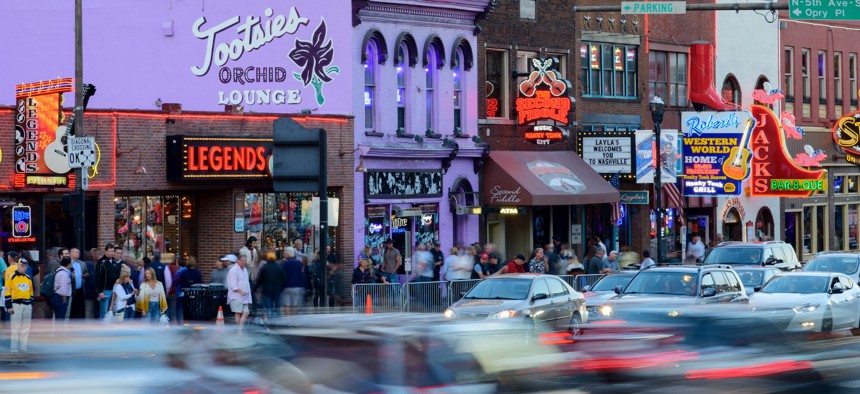What’s driving post-pandemic downtown recoveries?

Broadway in Nashville, Tennessee. Dukas/Christian Heeb/Universal Images Group via Getty Images
Data shows that many of the country’s largest downtowns have more residents now than before the pandemic, but residents alone can’t revitalize downtowns.
It will be a long time before people forget the eerie emptiness of city centers during the early months of the pandemic. Many then and now wondered if downtowns would ever recover from the exodus of residents and office workers, and from the shuttered retail shops and restaurants. But three years later, downtowns are inching toward recovery, and in many cases are home to more full-time residents today than before the pandemic.
The data from a new report refutes the urban exodus narrative of the last few years. To the contrary, the numbers show that in the second quarter of 2023, the median city residential population reached 111% of the pre-pandemic level, according to an analysis from Philadelphia’s Center City District. The report, which looks at anonymized location data from cellphones in 26 urban areas, found that in San Antonio, that figure hit 160%, while Boston sat at the low end of the spectrum with 96% of its pre-pandemic residential population.
“The continuing growth of downtown residential populations not only helps with the diversification of city center land-use and the reuse of older office and warehouse buildings,” the report says, “it also adds momentum to the return to office and support for all those jobs that rely on the presence of other workers.”
Indeed, residential recovery alone is not enough to return downtowns to their buzzy, vibrant pre-pandemic selves. Compared to workers and visitors, residents make up a small slice of people downtown on any given day. In 2019, residents in Portland, Oregon, Philadelphia, Seattle and San Francisco made up only between 11% and 13% of people downtown. In San Antonio, residents only accounted for 1% of people downtown.
When combining cumulative activity data on residents, workers and visitors, recovery rates are less robust, ranging from 69% of pre-pandemic activity in San Francisco to 100% in Nashville, Tennessee. Only Nashville and San Jose, California, which hit 92%, reached more than 90% of pre-pandemic activity.
But the report cautions cities against neglecting residents in their recovery plans. It’ll take a multifaceted approach to revitalize city centers, and housing is an essential part of the broader solution.
“The more we offer flexible zoning or financial incentives to facilitate the transition from office and warehouse to hotel, apartment or dormitory, the sooner our downtowns will fully rebound,” the report states. Land-use diversification is also critical to recovery, and a mix of education, health care, residential, hotel and retail establishments will accelerate the return of vibrant downtowns.
The rise of remote work and vacant office spaces has put a spotlight on adaptive reuse, and communities nationwide are looking for ways to encourage commercial-to-residential conversions. The Biden administration is playing a role too, making billions available for such renovations. While these projects are a tool in addressing the nation’s housing shortage and contributing to downtown revitalization, “it will take an extraordinarily high number of new residents to compensate for any continuing absence of office workers.”
That’s where the importance of visitors becomes apparent.
Across the 26 cities, visitors comprised two-thirds of people downtown, underscoring the importance of developing downtown attractions. While local variations influence a city’s recovery, the report notes that “in general, cities that have strong overall recovery rates tend to have a robust leisure and hospitality industry … a lower dependence on certain industries like information technology and financial services … and a high downtown residential density, facilitating shorter commutes to work.”
As for workers coming back to downtowns, the median recovery rate was 65%. The cities with the lowest worker recovery rates—San Francisco, Portland, Denver and Seattle—are home to large tech companies that had been implementing remote work policies even before 2020. At 85%, San Antonio had the highest rate of worker recovery. There are several factors that could be behind the disparities in worker recovery rates, the report suggested, including the duration of local closure mandates during the pandemic and perceptions around public safety.
In addition to a global pandemic, 2020 ushered in a reckoning period during which police departments came under intense scrutiny. Many communities lost law enforcement personnel, both as a result from calls to defund the police and from those leaving the profession. This shift, combined with near-empty streets and shuttered businesses, made homelessness and addiction more visible in many communities and bolstered the perception that downtowns were unsafe.
Critically, a sense of safety is key to getting more residents, visitors and workers back downtown, the report notes. In a large business improvement district in Philadelphia, unarmed “community service representatives” coordinate with police officers to respond to calls. Violent crime this year was 5% below pre-pandemic levels. Similar offenses in other areas that don’t focus on community policing, meanwhile, saw sharp increases.
“Clean and safe downtowns were important before the pandemic and they are more essential now, with the added challenge of rethinking and rebuilding confidence in public safety programs,” the report states.






